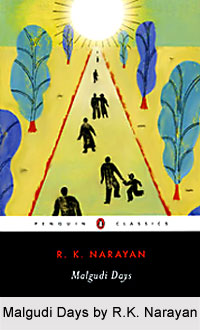The Indian English novels were developed as a subaltern awareness; as a response to break away from the colonial literature. Hence the post colonial Indian literature witnessed a revolution against the idiom which the colonial writers followed.
Eventually the Indian English writers started employing the techniques of mixed language, magic realism garnished with native themes. Hence from a post colonial era Indian English literature ushered into the contemporary and then the post-modern era. The saga of the Indian English novel therefore stands as the tale of changing tradition, the story of a changing India
Coming of English language and literature
The English language was transplanted into India because British East India Company, soon after establishing their rule in India, began to feel a communication gap between the British rulers and the natives. In order to solve the communication problem, which was a major hindrance in an alien land, consequently, Charles Grant, one of the directors of East India Company, pleaded for the adoption of the English language in 1792. Later on after a gap of forty-three years, the English language was adopted in 1835 by a brief resolution of the Governor General in council for the promotion of the European literature and Science among the natives of India.
 Evolution of English literature
Evolution of English literature
In the initial days, the stories and concepts were steeped in folklores, myths, written in umpteen languages as India is always the land of tales. In the mid nineteenth century, Raja Ram Mohan Roy, had initiated social reform programmes and in the process, favoured the English language for spreading the wealth of information and culture available in British publications. Raja Ram Mohan Roy, a master of Sanskrit, Persian and Arabic languages, felt that all renaissance knowledge was compiled mainly in the European languages. At first the Indians reacted with suspicion towards the English language, but later on welcomed it with open arms. English language was granted a special place in India.
The initial requirement of the Indian writing in English was the English knowing people. Various factors contributed in the creation of a mass expressing itself in English. One of the major factors was the introduction of the English education in India. Despite suspicion from a section of society that English education was being introduced to create a class of clerks and sycophants who will consequently harm the social and cultural fabric of India; it encouraged the cultivation and mastery of English as a language. Gradually more and more people came in contact of English language and literature.
The nineteenth century intellectuals began to question the orthodox prejudices, dogmas and superstitions that prevailed in India. The impact of Western learning gave a new impetus to Indian renaissance. Indian society underwent a metamorphosis. The revival of Indian classical learning and the introduction and the study of European arts and sciences gave rise to an unprecedented awakening in India. For the first time in India, a middle class of intellectuals began to emerge from the feudal society, giving rise to intense nationalism, during which the Indians struggled to articulate their passionate thoughts and feelings through whatever means were available to them. Writers like BankimChandra Chatterjee, Swami Vivekananda, Dinabandhu Mitra, Saratchandra Chatterjee caught up in the provincial patriotism, revived the regional languages, others believing that the English rule had come to stay studied and used the language of the rulers, giving rise to a new genre of Indian English, initially termed as Anglo-Indian literature.
The books like "The Rig Veda and the Upanishads", "The Thirty Two Stories of the Throne", Somadeva`s "Kathasaritsagara", "Arthasastra" were translated into English. While on the contrary, the first English novel in India is written by Bankim Chandra chatterjee (Rajmohan`s Wife in 1864). Other followed Lal Behari Dey`s "Govind Samant" (1876), Raj Lakshmi Devi`s "The Hindu Wife" (1876), Toru Dutt`s "Bianca" (1878) and many others.
Later, the concept of Indian English novel or rather the concept of Indians writing in English came much later and it is with the coming of Raja Rao, R.K. Narayan, Mulk Raj Anand, the journey of Indian English Novel began. The social disparity of India which was aptly described by Mulk Raj Anand in his Coolie, the imaginary village life with its entire unedited realities in R.K. Narayan`s Malgudi Days and last but not the least the aura of Gandhism depicted by Raja Rao in his remarkable novel Kanthapura portrayed a whole new India. The need of the foreigners depicting India amidst their write ups was not needed as Indians wanted to portray India through their Indian English. That was the beginning of the voyage and with time it gained maturity.
Revival of Indian English Novel
Not just the daily lives, not just the social issues, Indian English novel slowly unveiled the grotesque mythical realities of India while opening the window to a plethora of writers. Salman Rushdie (Midnight Children) fascinated the Indian intelligentsias with his remarkable understanding of Indian History, as well as unification of Indian history with language. This further paved the way to portray India with her sheer grandeur, tradition, realities, myths, heritage in the most eloquent way. Perhaps this supported Amitav Ghosh to dabble the post colonial Indian realities, while it also helped Vikram Seth to visualise a rather new India laced with an air of Victorian aristocracy.
 Developments in Indian English Novel
Developments in Indian English Novel
The history of Indian English novel, a journey which began long back has witnessed a lot of alteration to gain the current stylish contour. In the past few years many prominent writers have made a mark on the Indian Diaspora. Eminent writers like Arundhati Roy, Jhumpa Lahiri, Shobha De, V.S Naipaul, Shashi Tharoor etc. have given Indian English novel a whole new level. The novels include various concepts of fact and fiction and are based on current events and recent social problems. Women writers usually explore old wives tales, condemn exploitation and try to make sense of the fast changing pace of the new world. Kamala Das explores women`s plight in India and the world and others like Shashi Deshpande paint characters who blame their own complacence for their remorseful condition. Arundhati Roy begins her story without a beginning and does not really end it while Jhumpa Lahiri`s well-crafted tales move at a perfect pace.
Amongst the new young writers, the most talented is perhaps Chetan Bhagat. With four back to back bestselling novels, like One Night @ the Call Center, Five Point Someone, 2 States and The 3 Mistakes of My Life, Chetan Bhagat has single-handedly reshaped the future of Indian English novels. The influence of Bhagat`s writing has been so impact, that even Hindi films are adapting his novels on to the big screens. Another contemporary writer who has gained immense popularity in the recent times is Amish Tripathi. With his Novel, The Immortals of Meluha, based on the origin of Lord Shiva, Amish has captured the imagination of the country. After the success of the novel, the writer has planned two successive sequels as well. The second book in the trilogy has also been released recently, titled The Secret of the Nagas. It deals with the origin of the Nagas and their encounter with Lord Shiva. The book, although received mixed reviews, has already become a best-seller. The third book in the Shiva trilogy series, titled The Oath of the Vayuputras, by author Amish Tripathi, is now waiting to publish. Other modern books are "I Have A Dream" (Rashmi Bansal), "Bollywood Extras" (D.D Bruno Starrs) and the English translation of Ashok Kumar Pedhinti`s Telugu novel "Zigri" are popular among the Indian readers. In 2012 Sharath Komarraju wrote several books like Murder In Amaravati and Banquet on the Dead. "A Mysterious Death at Sainik Farms" is written by Rukmani Anandani published by Rupa Publications in this year.
Indian English novel has gone through sea changes since its inception and has attained a whole new intensity in terms of concept, marketing, presentation, business and impact on the Indian culture.













